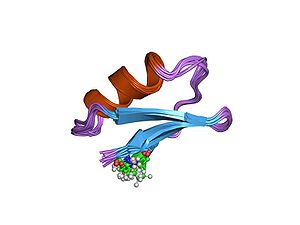- Charybdotoxin
-
Charybdotoxin 
Refined model of Charybdotoxin[1] Identifiers Symbol ? PDB 2crd Other data Charybdotoxin (CTX) is a 37 amino acid neurotoxin from the venom of the scorpion Leiurus quinquestriatus hebraeus that blocks calcium-activated potassium channels.[2] This blockade causes hyperexcitability of the nervous system.
Contents
Chemical properties
Scorpions such as the deathstalker paralyze their prey by injecting a potent mix of peptide toxins.[3] Charybdotoxin (CTX), a 37 amino acid neurotoxin, is one of the peptide toxins that can be extracted from the venom of the scorpion. Its structure is very similar to that of margatoxin. Charybdotoxin contains three disulfide bridges.[4]
Mode of action
Charybdotoxin occludes the pore of calcium-activated voltage-gated K+ channels by binding to one of four independent, overlapping binding sites.[5][6] It binds both to the open and the closed states. In addition, the block is enhanced as the ionic strength is lowered.[7] The blockade of K+ channels by the charybdotoxin peptide causes neuronal hyperexcitability.
Treatment
Anti-scorpion venom serum (AScVS) is an effective and safe method of therapy in severe scorpion envenoming syndrome. Compared with other therapies like alpha blockers it has a relatively short recovery period (10 vs 16–42 hours).[8]
References
- ^ Ben-Tal N, Honig B, Miller C, McLaughlin S (October 1997). "Electrostatic binding of proteins to membranes. Theoretical predictions and experimental results with charybdotoxin and phospholipid vesicles". Biophys. J. 73 (4): 1717–27. doi:10.1016/S0006-3495(97)78203-1. PMC 1181073. PMID 9336168. http://www.pubmedcentral.nih.gov/articlerender.fcgi?tool=pmcentrez&artid=1181073.
- ^ Laurent F, Michel A, Bonnet PA, Chapat JP, Boucard M (March 1993). "Evaluation of the relaxant effects of SCA40, a novel charybdotoxin-sensitive potassium channel opener, in guinea-pig isolated trachealis". Br. J. Pharmacol. 108 (3): 622–6. PMC 1908044. PMID 7682131. http://www.pubmedcentral.nih.gov/articlerender.fcgi?tool=pmcentrez&artid=1908044.
- ^ Purves D, Augustine GJ, Fitzpatrick D, Hall WC, Lamantia AS, McNamara JO, Williams SM. Neuroscience, p82.
- ^ Avdonin V, Nolan B, Sabatier JM, De Waard M, Hoshi T (August 2000). "Mechanisms of maurotoxin action on Shaker potassium channels". Biophys. J. 79 (2): 776–87. doi:10.1016/S0006-3495(00)76335-1. PMC 1300977. PMID 10920011. http://www.pubmedcentral.nih.gov/articlerender.fcgi?tool=pmcentrez&artid=1300977.
- ^ Thompson J, Begenisich T (May 2000). "Electrostatic interaction between charybdotoxin and a tetrameric mutant of Shaker K(+) channels". Biophys. J. 78 (5): 2382–91. doi:10.1016/S0006-3495(00)76782-8. PMC 1300827. PMID 10777734. http://www.pubmedcentral.nih.gov/articlerender.fcgi?tool=pmcentrez&artid=1300827.
- ^ Naranjo D, Miller C (January 1996). "A strongly interacting pair of residues on the contact surface of charybdotoxin and a Shaker K+ channel". Neuron 16 (1): 123–30. doi:10.1016/S0896-6273(00)80029-X. PMID 8562075. http://linkinghub.elsevier.com/retrieve/pii/S0896-6273(00)80029-X.
- ^ MacKinnon R, Reinhart PH, White MM (December 1988). "Charybdotoxin block of Shaker K+ channels suggests that different types of K+ channels share common structural features". Neuron 1 (10): 997–1001. doi:10.1016/0896-6273(88)90156-0. PMID 2483094. http://linkinghub.elsevier.com/retrieve/pii/0896-6273(88)90156-0.
- ^ Natu VS, Murthy RK, Deodhar KP (April 2006). "Efficacy of species specific anti-scorpion venom serum (AScVS) against severe, serious scorpion stings (Mesobuthus tamulus concanesis Pocock)—an experience from rural hospital in western Maharashtra". J Assoc Physicians India 54: 283–7. PMID 16944610.
Channel blocker: potassium channel blockers Antiarrhythmic III/delayed rectifier benzofuran (Amiodarone) • quaternary ammonium (Bretylium) • naphthalene (Bunaftine) • phenethylamine (Dofetilide) • sulfonamide (Ibutilide) • pyrimidinone (Nifekalant) • ethanolamine (Sotalol) • cyclopropane (Tedisamil) • E-4031Other/ungrouped/unknown aminopyridines (3,4-Diaminopyridine, 4-Aminopyridine) • indole (Linopirdine, Paxilline) • quaternary ammonium (Tetraethylammonium) • peptide (Maurotoxin, Charybdotoxin)Categories:- Neurotoxins
- Ion channel toxins
- Invertebrate toxins
Wikimedia Foundation. 2010.
